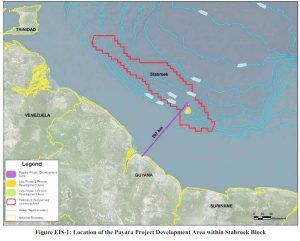ExxonMobil commits to handle costs to clean up spills from Guyana operations that affect T&T, Venezuela & others
(Kaieteur News) According to the Environmental Impact Assessment (EIA) that was done for ExxonMobil’s third Stabroek Block project called Payara, an unmitigated oil spill can affect Guyana’s Continental and Caribbean neighbours such as Trinidad and Tobago, Venezuela, Aruba, Bonaire, and Curaçao.
In light of this, ExxonMobil’s subsidiary, Esso Exploration and Production Guyana Limited (EEPGL) has committed to taking a number of steps to help safeguard these nations.
The EIA notes that EEPGL will work closely with representatives of the respective countries that could be potentially impacted by a large oil spill.
It intends to do this by coordinating operations and communications between different command posts; creating a transboundary workgroup to manage waste from a product release, including identifying waste-handling locations in the impacted regions and managing commercial and legal issues; and identifying places of refuge in the impacted region where response vessels could go for repairs and assistance.
EEPGL said it will also take steps to determine how impacted regional stakeholders can work together to allow equipment and personnel to assist in a spill response outside the region while still retaining a core level of response readiness within the jurisdictions.
It would also work on determining financial liability and establishing claims and/or livelihood remediation processes during a response to a transboundary event. The company also committed to working with local communities within the impacted areas to raise awareness of oil spill planning and preparations.
PAYARA PROJECT OVERVIEW
According to documents in the possession of the Environmental Protection Agency, EEPGL’s Payara development will be located in the eastern area of the Stabroek Block which is approximately 190 km (118 miles) from Georgetown.
The operator notes that oil production from Payara is expected to last at least 20 years with startup of the facilities expected to occur approximately in mid-2023.
EEPGL noted that it will drill approximately 35 to 45 wells offshore to support extraction of the oil from below the sea floor. It said that each well will be drilled using a floating drill ship.
Also, each well will be directionally drilled to specific reservoir targets generally 4,000 to 5,500 meters (m) below the sea level.
Further, EEPGL said it will install some of the oil production facilities on the sea floor at approximately 1,500-1,980 m (4,900-6,500 ft) water depth. It said that these subsea facilities include various types of pipes and hardware.
Kaieteur News understands that the subsea facilities allow the oil from the wells to be gathered and moved to the surface of the ocean for further processing. EEPGL will then install other oil production facilities on a vessel which floats on the surface of the ocean. 1,800-1,980 m (5,900-6,500 ft) of water depth and will remain on location throughout the life of the facility.
EEPGL said that oil production facilities on the FPSO will further process the oil extracted from below the sea floor.
The operator also stated that the FPSO will have the capacity to produce up to approximately 180,000 to 220,000 barrels of oil per day.
During the early stage of production operations, the FPSO is anticipated to produce up to an average of approximately 5,700,000 to 6,600,000 barrels of crude oil per month. These estimates are preliminary and are subject to change.
It was noted that the Project is expected to employ up to 600 persons during development well drilling, approximately 600 persons at the peak of the installation stage, and up to about 140 persons during production operations.
The vessel is called a Floating Production, Storage, and Offloading (FPSO) facility. It will be moored on location in approximately.





